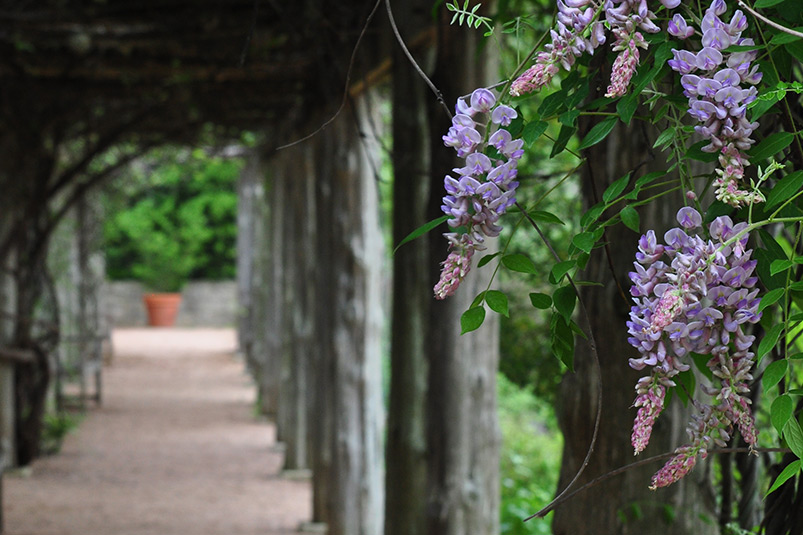Making the Shade

American wisteria (Wisteria frutescens) is one of many good choices for native gardens. This high-climbing vine is less aggressive than similar Asian species, and its lavender blooms add color and fragrance along with much-welcome shade. PHOTO Pam Penick
VINES ADD A CERTAIN ROMANCE TO THE SPRING OR SUMMER GARDEN, but they’re practical workhorses too. Planted on a pergola or arbor, they offer cooling shade while bringing the garden up to eye level. But vines can be intimidating, conjuring images of overgrown jungle that even Tarzan would shun. Indeed, many non-native vines, like English ivy and Japanese honeysuckle, grow rampantly enough to gobble up pergola, house and all — and perhaps spread invasively into neighboring greenbelts. Instead of such thuggish exotics, choose one of these native vines to clothe your shade structure, and save the Tarzan loincloth for Halloween.
Trumpeting spring’s arrival with a full brass section of golden-yellow flowers, evergreen Carolina jessamine (Gelsemium sempervirens) perfumes the air with sweet fragrance. All parts are poisonous, so keep away from indiscriminate toddlers and pets, but enjoy its graceful twining, which can be aided on large posts by attaching wire for the vine to climb.
Blooming from spring to frost, coral honeysuckle (Lonicera sempervirens) blushes with fanlike clusters of tubular, coral-red flowers that hummingbirds can’t resist. Another hummingbird magnet, crossvine (Bignonia capreolata) erupts in spring with large, two-tone flowers of brick red and yellow. “When it blooms, it’s just, ‘Wow!’” enthuses Wildflower Center Senior Horticulturist Julie Marcus. The popular cultivar ‘Tangerine Beauty’ offers crossvine in a pinkish orange, as well. Either will adhere to wood and stucco with grasping tendrils, so they’re best planted well away from the siding of your home.
Autumn brings out the beauty of other native vines, like old man’s beard (Clematis drummondii), whose creamy flowers go to seed in fluffy whorls of white. Unlike many vines that prefer deeper soil and regular moisture, this one can handle dry, rocky conditions, making it a good choice for Southwestern gardeners. Frost kills it to the ground, but it returns in spring.
Rebecca Sweet, a garden designer in northern California and co-author of “Garden Up!,” names grapevine Vitis californica ‘Roger’s Red’ as her top choice for cloaking a large arbor. “It tolerates light shade and has to-die-for garnet-red foliage in the fall,” she says. Tiny, sweet grapes dangling among the leaves are a bonus.
For something more unusual, consider Alamo vine (Merremia dissecta), whose large white flowers have a drop of wine-red in the center. The vine dies back in winter but quickly returns in spring to cover a large arbor. Like all morning glories, it seeds out aggressively, so remove unwanted seedlings in spring. California Dutchman’s pipe (Aristolochia californica), with mauve flowers resembling old-fashioned tobacco pipes, is another interesting choice and grows well in light shade. Pipevine swallowtails lay their eggs on it, so if you see caterpillars, just remind yourself that chewed leaves mean you’re supporting a healthy population of butterflies.
Whatever climber you choose, know that mature vines prefer plenty of sun, and — like sunbathers at the beach, with faces tipped up to the sky and toes tunneled in cool sand — their roots do best buried deep in moist soil. Give them these conditions in your garden and they’ll grow well.
Tips for Success
- Plant on east or north side of your arbor so that your vine can grow up into the sun while its roots chill in the shade. If you must plant on the west or south side, spread a couple of inches of mulch (try shredded hardwood, pine straw or pecan shells) around the base of the vine to preserve moisture in the soil. Stone is also a good insulator.
- Native vines require attention at first to train them up a pergola or arbor, but once established they need only occasional pruning to remove dead wood or keep them neat.
- Fertilizing is unnecessary, and if you’ve chosen appropriately for your conditions, vines don’t need much supplemental water once they’re established.
Pam Penick writes the gardening blog Digging and is the author of “Lawn Gone!” and “The Water-Saving Garden.”

